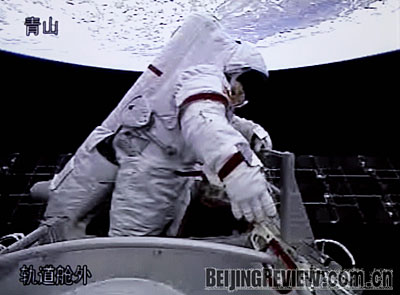|
 |
|
STEPPING OUT: Zhai Zhigang exits the capsule of Shenzhou 7 to begin his walk in space (CHEN JIANLI) |
When astronaut Zhai Zhigang waved China's national flag more than 300 km above the Earth in the dark void of space, down on the ground a nation beamed with collective pride. Despite his bulky spacesuit and tinted visor, everyone knew the name of their hero as he spacewalked into history.
As the leader of the three astronauts on the Shenzhou 7 mission, Zhai was only chosen as the space walker less than one day before he stepped out of the capsule on September 27, said Wang Zhaoyao, spokesperson for China's manned space program, at a press conference on September 27.
The three astronauts, Zhai Zhigang, Liu Boming and Jing Haipeng, were all born in 1966 and have trained for the manned space mission for almost 10 years. Zhai was on the final list for both the Shenzhou 5 and Shenzhou 6 missions in 2003 and 2005, respectively, but didn't get to make those trips. This time, he finally got his chance to make a big leap forward for China's space industry.
Zhai and Liu, who assisted his space walk, entered the orbit module to make preparations after breakfast on September 27, while Jing stayed in the reentry module to monitor the vessel operation.
Anxious moments
Zhai floated from the cabin wearing a China-made Feitian (literally means flying in the sky) spacesuit at about 4:43 p.m. and stayed in outer space for almost 20 minutes. He was watched by millions of viewers worldwide, as he waved the national flag, waved to the mounted camera and then went about fetching a test sample of solid lubricant placed outside the orbital module.
"As a man who works for China's manned space engineering program, watching Zhai Zhigang walking in space is like a mother watching her child," said Deng Yibing, Chief Engineer of the China Astronaut Research and Training Center, to journalists at the Shenzhou 7 Manned Space Flight Media Center in Beijing. "Although those were just small steps, I am so happy and satisfied," said Deng.
During the 20 minutes, Zhai walked a total length of 9,165 km in space, equaling about one fourth of the earth's circumference at the equator.
"We trained many times by imitating the environment of outer space before the space walk, but it is impossible to duplicate the conditions exactly. That means there were always risks for this mission," said Wang. "So it is really a big success for this space walk to be conducted so well and smoothly," he said.
President Hu Jintao congratulated the astronauts telephonically after the success of the space walk.
Shenzhou's next step
Two hours after the space walk was completed, a small monitoring satellite was launched.
Equipped with two cameras to capture images at a distance between 4 meters and 2 km, the accompanying satellite's task is to assist Shenzhou 7 in communication, scientific experiments, and earth and astronomy observations.
"The task will test our ability to observe and control two objects in relative motion in space. Through this, we will prepare for the future orbiter docking," Zhao Guangheng, Deputy Chief Designer of the manned space program's space application system, told Xinhua News Agency in an earlier interview at the Jiuquan Satellite Launch Center.
After Shenzhou 7, the next manned space mission will be Shenzhou 10, which is a more demanding mission seeking a breakthrough in the orbiter docking technology.
The second round of astronauts selection will begin after the Shenzhou 7 mission and candidates of the new selection might be involved in the Shenzhou 10 mission, said Deng.
The first batch of 14 astronauts was selected in 1998 for China's manned space flights. Among the 14, Yang Liwei was sent into space in 2003 in the Shenzhou 5 spacecraft, and another two astronauts orbited the earth in Shenzhou 6 in 2005. This time, Shenzhou 7 carried three astronauts.
"Some of the 14 astronauts are capable of fulfilling the Shenzhou 10 mission as their ages and skills will not be a problem," said Deng, "but some of them will retire due to their age. The retired astronauts will join the training programs or the management team."
The orbiter docking technology will first be tested on the unmanned Shenzhou 8 and Shenzhou 9 spacecraft. Grasping the orbiter docking technology is China's second step before the ultimate goal of building a permanent space station. | 